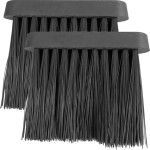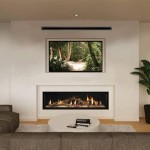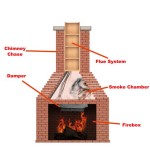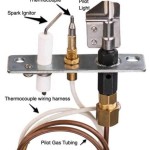River Rock Fireplace DIY: A Comprehensive Guide
A fireplace serves as a focal point in many homes, providing warmth and aesthetic appeal. While professionally installed fireplaces can be costly, a do-it-yourself (DIY) river rock fireplace offers a more economical and customizable alternative. This article provides a comprehensive guide to constructing a river rock fireplace, detailing the necessary materials, tools, and procedures. Adhering to safety precautions and local building codes is crucial throughout the entire project.
Planning and Preparation
Before commencing any construction, thorough planning is essential. The first step involves assessing the existing structure and the proposed location of the fireplace. Consider the dimensions of the space and determine the desired size and style of the river rock surround. Accurate measurements will facilitate material estimations and prevent errors during construction.
Next, research local building codes and regulations pertaining to fireplace construction. These codes often dictate specific requirements for fire safety, ventilation, and structural integrity. Obtaining the necessary permits is mandatory to ensure compliance and avoid potential legal issues. Failure to adhere to building codes can result in fines and necessitate costly modifications.
Selecting the appropriate materials is paramount to the success and longevity of the project. River rock, the primary material, can be sourced from local quarries, landscaping suppliers, or online retailers. The size, color, and texture of the stones should be carefully considered to achieve the desired aesthetic. It is advisable to acquire a surplus of river rock to account for breakage and variations in size and shape.
In addition to river rock, other materials such as mortar, cement board, metal lath, and fire-rated sealant are required. The mortar acts as the binding agent, securing the stones to the underlying structure. Cement board provides a fire-resistant backing, while metal lath enhances the adhesion of the mortar to the cement board. Fire-rated sealant is used to seal gaps and prevent the escape of smoke and gases.
Gathering the necessary tools is equally important. Essential tools include a mortar mixer, trowel, level, hammer, chisel, safety glasses, gloves, and a wet saw or angle grinder with a diamond blade for cutting stones. A wheelbarrow or similar container will be needed for transporting materials. Ensuring that all tools are in good working order prior to starting the project will streamline the construction process.
Constructing the Fireplace Base
The foundation of a river rock fireplace is the base, which provides structural support and a level surface for the stone surround. If an existing fireplace already exists, it is crucial to inspect the existing structure for any signs of damage or deterioration. Repairs should be made as needed to ensure the structural integrity of the base.
If a new base is required, the construction process begins with framing the structure using wood or metal studs. The dimensions of the frame should correspond to the planned size of the fireplace. Ensure that the frame is square and level before proceeding to the next step.
Once the frame is constructed, cover the exterior with cement board. Cement board is a fire-resistant material that provides a stable surface for the river rock veneer and protects the underlying structure from heat. Secure the cement board to the frame using screws designed for this purpose. Overlap the edges of the cement board to create a seamless barrier.
Apply metal lath over the cement board to enhance the adhesion of the mortar. The metal lath provides a textured surface that allows the mortar to grip effectively. Secure the metal lath to the cement board using staples or screws. Ensure that the metal lath is taut and free of wrinkles.
With the base prepared, apply a scratch coat of mortar to the metal lath. The scratch coat is a thin layer of mortar that provides a bonding surface for the subsequent layers of mortar. Use a trowel to apply the mortar evenly and create a rough texture. Allow the scratch coat to cure for at least 24 hours before proceeding.
Applying the River Rock Veneer
The application of the river rock veneer is the most visually striking aspect of the project. Careful planning and execution are essential to achieve a professional and aesthetically pleasing result. Before applying the stones, it is beneficial to arrange them on the ground to visualize the desired pattern and color distribution.
Mix the mortar according to the manufacturer's instructions. The consistency of the mortar should be similar to that of peanut butter, allowing it to adhere to the stones without being too runny. Avoid adding excessive water, as this can weaken the mortar and compromise its bonding strength.
Apply a generous layer of mortar to the back of each stone. The mortar should completely cover the back of the stone to ensure a strong bond. Press the stone firmly into the scratch coat, ensuring that it is level and aligned with the adjacent stones. Use a level to check the alignment and make adjustments as needed.
Continue applying the stones, working from the bottom up. Vary the size, shape, and color of the stones to create a natural and visually appealing pattern. Leave small gaps between the stones to allow for expansion and contraction. These gaps will be filled with mortar later in the process.
For stones that are too large or awkwardly shaped, use a wet saw or angle grinder with a diamond blade to cut them to the desired size and shape. Wear safety glasses and gloves when cutting stones to protect yourself from debris and sharp edges. Smooth the cut edges with a grinding stone to prevent injuries.
Allow the mortar to cure for at least 24 hours before proceeding to the next step. This allows the mortar to harden and bond the stones firmly to the base. Avoid disturbing the stones during the curing process.
Grouting and Finishing
After the mortar has cured, the gaps between the stones need to be filled with grout. Grouting provides structural support and enhances the aesthetic appeal of the fireplace. Select a grout color that complements the color of the river rock.
Mix the grout according to the manufacturer's instructions. The consistency of the grout should be similar to that of thick paste. Use a grout float to apply the grout to the gaps between the stones. Work the grout into the gaps thoroughly, ensuring that they are completely filled.
Remove excess grout from the surface of the stones using a damp sponge. Rinse the sponge frequently to prevent the grout from drying on the stones. Be careful not to remove too much grout from the gaps.
Allow the grout to cure for at least 24 hours before proceeding to the next step. This allows the grout to harden and set properly. Avoid disturbing the grout during the curing process.
Once the grout has cured, apply a sealant to the river rock veneer. The sealant protects the stones from moisture and stains, and it enhances their color and texture. Select a sealant that is specifically designed for use on natural stone.
Apply the sealant according to the manufacturer's instructions. Use a brush or roller to apply the sealant evenly to the surface of the stones. Allow the sealant to dry completely before using the fireplace.
Inspect the finished fireplace for any gaps or cracks. Use fire-rated sealant to seal any gaps or cracks to prevent the escape of smoke and gases. This is particularly important around the firebox and chimney.
Safety Considerations
Fire safety is of paramount importance when constructing a river rock fireplace. Ensure that all materials used in the construction are fire-resistant or fire-rated. This includes the cement board, mortar, grout, and sealant.
Proper ventilation is crucial for a safe and efficient fireplace. Ensure that the fireplace has a properly sized chimney and that the chimney is free of obstructions. Regular chimney inspections and cleanings are essential to prevent chimney fires.
Install a carbon monoxide detector in the vicinity of the fireplace. Carbon monoxide is a colorless, odorless gas that can be deadly. A carbon monoxide detector will alert you to the presence of carbon monoxide in your home.
Never leave a fire unattended in the fireplace. Always extinguish the fire completely before leaving the room or going to bed. Use a fireplace screen to prevent sparks and embers from escaping the fireplace.

How To German Smear A Dated River Rock Fireplace Krista Gilbert

Fireplace River Rock Fireplaces House Design Cob

River Stone Fireplaces Rock Fireplace Design

Diy River Rock Fireplace Painted White Fireplaces Stone Makeover

Diy Faux Stone Fireplace Build Field Cottage Stove Surround

River Rock Fireplace Insteading

River Stone Fireplace Detail For Rock Home Ideas Fireplaces Designs

How To German Smear A Dated River Rock Fireplace Krista Gilbert

60 River Rock Stone Molds Make 1000s Fireplace Wall Veneer Free

River Rock Fireplace Insteading
Related Posts








